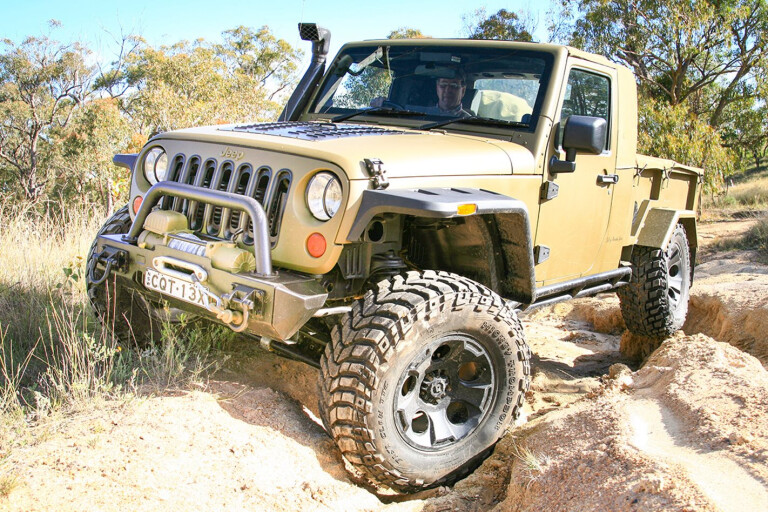
THE JK Jeep Wrangler has always provided the Jeep community with a plethora of customising alternatives.
This was originally published in September 2014 issue of 4X4 Australia.
In fact, the JK range has given Jeep a mighty boost within the off-road fraternity, as well as with the bitumen-based gang. There’s no shortage of off-the-shelf custom options for the Wrangler, both practically and aesthetically, but no-one could have imagined the creativity behind Neil Goodridge’s modified JK.
 Neil, owner of well-known Jeep specialist company Marathon Spares in Tamworth, New South Wales, decided to have a crack at re-creating a Kaiser M715 with his own additional styling cues. A group in the US also attempted the project and spent almost $US200K doing so. While it was a great job, it didn’t quite hit the nail on the head.
Neil, owner of well-known Jeep specialist company Marathon Spares in Tamworth, New South Wales, decided to have a crack at re-creating a Kaiser M715 with his own additional styling cues. A group in the US also attempted the project and spent almost $US200K doing so. While it was a great job, it didn’t quite hit the nail on the head.
Cue Neil. In his nonchalant way, he figured he’d have a go, but with a much lower budget and fewer people involved. He aimed for a more usable finished product and based it on the mighty JK Wrangler platform, with an inter-cooled 2.8-litre turbo-diesel and a six-speed manual gearbox.
He is planning on installing a Sprint Booster, which basically allows for adjustable throttle delay or response to make the most of the already brilliant diesel engine.
 Neil wanted to give people an idea what a modern day army Jeep ute would look like, but he admits his creation is not an exact replica of the 1960 M715. The rear ute tub is modelled on a ‘deuce and a half’, a two-and-half-ton army M35 truck.
Neil wanted to give people an idea what a modern day army Jeep ute would look like, but he admits his creation is not an exact replica of the 1960 M715. The rear ute tub is modelled on a ‘deuce and a half’, a two-and-half-ton army M35 truck.
Neil got creative to ensure the finished product’s loo’ was the right proportion and shape. While he had an original M715 to copy, he tossed the tape measure and replaced it with instinct and experience.
When working on the mud guards, Neil utilised a set of ‘flat fender’ style Hurricane Rugged Ridge units on the front end. Down back he fabricated his own squared-off rears to match, instead of going for the original rounded version. Initially piecing together a cardboard model to shape the templates, the finished guards use 2.1mm steel, which also double as a great foot-step into the tray.
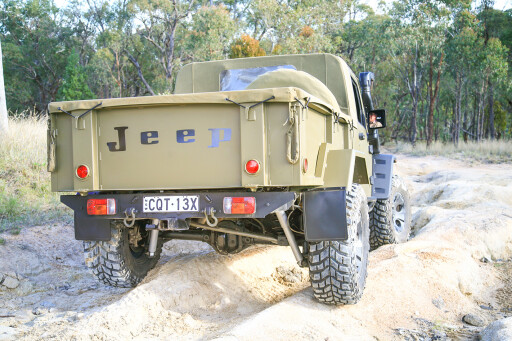 The tray utilises a spare WWII Jeep army trailer Neil had laying around in the paddock. The standard trailers ribbed floor was widened and lengthened to provide a very usable 1.8x1.5m tub with external guards. The standard fuel filler which resided in the rear quarter of the JK was repositioned just forward of the wheel arches.
The tray utilises a spare WWII Jeep army trailer Neil had laying around in the paddock. The standard trailers ribbed floor was widened and lengthened to provide a very usable 1.8x1.5m tub with external guards. The standard fuel filler which resided in the rear quarter of the JK was repositioned just forward of the wheel arches.
Army-style hooks were added to hold down the drab green tonneau cover, which was custom fabricated by Goodridge Industries in Tamworth.
Neil imported a set of black 17x9in Rugged Ridge alloy rims wrapped in aggressive 315/70R17 directional Baja Claws. To provide clearance from the body work and tyres, a set of raised two-inch TeraFlex coils combined with TeraFlex gas shocks and JKS sway bar disconnects provide a flexible off-road package combined with good on-road manners. Neil isn’t a fan of huge lifts; he’d rather go low and wide to enhance stability in all driving situations.
The standard front Dana 30 has been strengthened via an axle tube kit and braces to prevent breakage during aggressive off-roading, and the RCV axles are chromoly steel and warranted (in the US) to withstand abuse from whopping 42-inch rubber.
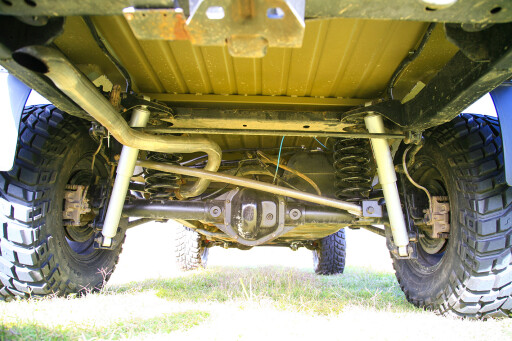 The rear Dana 44 has been left as is; although, both diffs have ARB AirLockers installed to help with traction. The air compressor is tucked away behind the passenger’s seat, while the switches are roof-mounted in a custom box that also houses the matching forward lighting rocker switch.
The rear Dana 44 has been left as is; although, both diffs have ARB AirLockers installed to help with traction. The air compressor is tucked away behind the passenger’s seat, while the switches are roof-mounted in a custom box that also houses the matching forward lighting rocker switch.
With the larger diameter rubber, the ‘overdriven’ final ratio with standard diff ratios saw both fuel economy and performance go out the window, so Neil has changed diff ratios to 4.11, making room for the 35-inch tyres to provide a ‘close-to-factory’ final drive.
A Currie steering arm and heavy duty tie rod, adjustable TeraFlex lower control arms (to adjust caster angles), combined with a high mount drag link kit (to allow for parallel steering geometry) enhances the off-road flex of the five-link front end and sharpens on-road steering while eliminating steering wobble at speed.
The rear adjustable panhard rod (or track bar) allows the whole axle assembly to be centralised laterally, given the suspension lift can slightly offset the whole axle to one side.
CHOP CHOP
THIS ute started life as a four-door JK Jeep Wrangler, had been painted in sky blue livery, and was well and truly used by the previous owner. Once the rear end had been chopped with the angle grinder, a half-height rear wall was handcrafted with 1.2mm sheet to match in with the handmade side walls and roof line.
Neil was adamant about using a canvas roof and top half of the rear wall to emulate the original M715 Jeep and selected original US army issue drab green misled canvas to fulfil the task, which Goodridge Industries dutifully completed. They utilised standard JK soft top roof bows along with the original roll bar to form an original roof line. Factory seat belts, seats and front doors have all been retained.
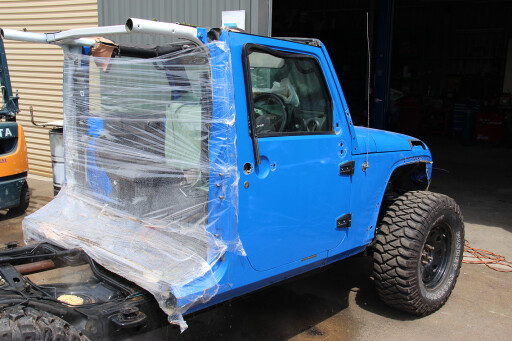 A rear clear panel was incorporated into the canvas work to allow easier rear view, while small lower vents have been installed to prevent the canvas ‘ballooning’ at higher speeds.
A rear clear panel was incorporated into the canvas work to allow easier rear view, while small lower vents have been installed to prevent the canvas ‘ballooning’ at higher speeds.
While Neil could have fabricated the ute tub to match the standard chassis length, he figured it just wouldn’t look in proportion with the rest of the vehicle, so he opted to lengthen the chassis. This was completed by chopping the rear chassis section, grafting in a strengthened 400mm chassis section and then re-connecting the original rear chassis to the rest of the vehicle.
This has allowed for fitting of rear bar work, as well as incorporating the standard towbar mounting and recovery points, which made final engineering easier. Neil consulted an engineer before laying a finger on his Mauler project, together with follow up and final checks to ensure total legality.
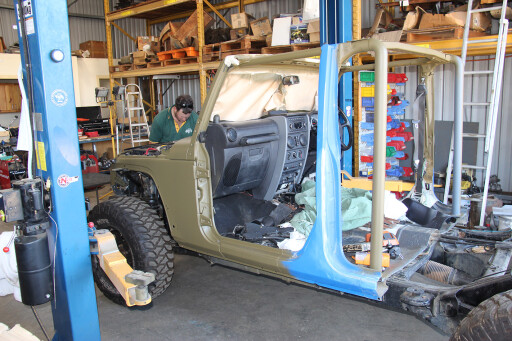 To help ward off rock rash, Neil also installed a set of Rugged Ridge sliders from a four-door Wrangler. These longer sliders also help protect the clever custom foot step into the ute tub and are connected directly to the Wrangler chassis for maximum strength.
To help ward off rock rash, Neil also installed a set of Rugged Ridge sliders from a four-door Wrangler. These longer sliders also help protect the clever custom foot step into the ute tub and are connected directly to the Wrangler chassis for maximum strength.
Up front, this Wrangler sports a single hoop design Rugged Ridge bar fitted with a 9000-pound winch with Dyneema winch rope and alloy Hawse fair lead, and a whopping pair of D-shackles for securing recovery gear.
While this type of bar doesn’t offer maximum ’roo strike protection, taking a glance from the side of this Wrangler shows the (almost) 90-degree approach angle – hence the use of this type of bar for maximum off-road advantage. The rear bar, which incorporates the towbar, also sports a set of recovery shackles to help hook up the winch or strap.
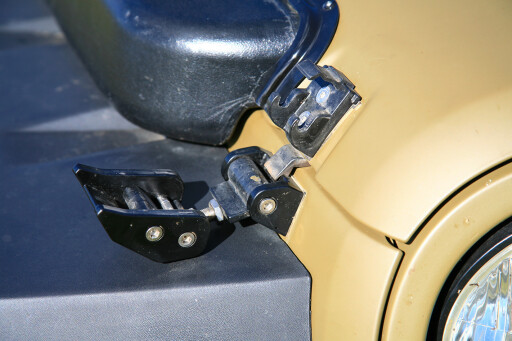 The standard rubber bonnet latches have been replaced by more secure, adjustable aluminium versions. A Wrangler-stamped snorkel keeps the diesel engine sucking cool clean air, while a vented bonnet infill allows a little engine heat to escape.
The standard rubber bonnet latches have been replaced by more secure, adjustable aluminium versions. A Wrangler-stamped snorkel keeps the diesel engine sucking cool clean air, while a vented bonnet infill allows a little engine heat to escape.
Having spent some time driving this ute, we can attest to the overall brilliant on-road driveability combined with off-road, go-anywhere ability.
Sure the Claws are a little noisy on road, the soft top allows a bit of road noise in, and there isn’t all that much room behind the seats, but having driven a stack of modified 4x4s over the years, many of which drive like dogs on the road, some that don’t perform off-road and some that just shouldn’t have left the drawing board, we reckon this is one hell of a ute that drives better than stock and would tackle pretty much anything you could throw at it; hence the Marathon Mauler tag.
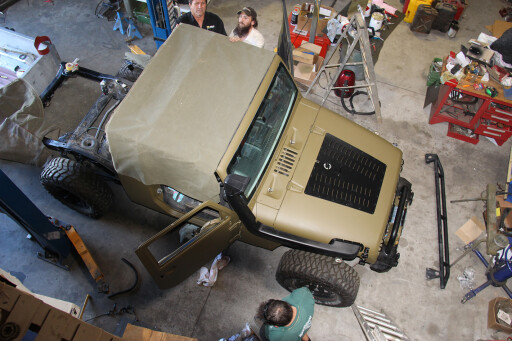 It looks pretty damn cool, too. Well done, Neil, your hands-on skills are brilliant, your foresight and perception to build a vehicle that not just performs well but looks good is top notch.
It looks pretty damn cool, too. Well done, Neil, your hands-on skills are brilliant, your foresight and perception to build a vehicle that not just performs well but looks good is top notch.
We can’t wait to see your next creation. Word has it you’re working on something with more doors than the Mauler, longer than the Mauler, and possibly even more impressive than what the high-budget overseas counterparts have tried to create. Best of luck!

COMMENTS